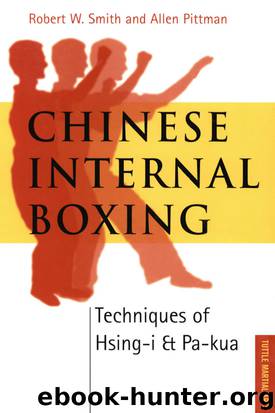Chinese Internal Boxing by Robert W. Smith & Allen Pittman

Author:Robert W. Smith & Allen Pittman
Language: eng
Format: epub
Publisher: Charles E. tuttle Publishing Company, Inc.
HISTORY AND MASTERS
The origin of Pa-kua is unknown. The first specific reference to it is 1796, when it was recorded that a boxer in Shantung named Wang Hsiang taught the art to a certain Feng Ke-shan. In 1810 Feng met a Niu Liang-ch'en, who also taught him certain aspects of the art. The traditional teaching, however, is that Tung Hai-ch'uan (1798-1879) of Hopei Province is its modern progenitor.
Tung Hai-ch'uan was a poor boy from Hopei province who, after some scrapes in Peking, journeyed to Mount Omei in Szechwan Province, where he met two Taoists, Ku Chi-tzu and Shang Tao-yuan (the surnames are standard but the given names have strong Taoist connotations, and hence are probably "religious" names), who taught him Pa-kua for eleven years. For seven years he reportedly walked around a tree until it seemed to lean toward him, at which time he became enlightened and reported his experience to the Taoists. They then had him do a figure-8 walk circling two trees, which he did for two years until it seemed that the trees began to "pursue" him. The Taoists praised him and asked if he were homesick. When he acknowledged that he was, they congratulated him on not losing his natural feelings and then taught him hand changes and weapons techniques for two years, after which he returned home to Hopei and then went to Peking, where he taught a number of students.
After becoming famous in Peking, Tung was challenged by Kuo Yun-shen ("Divine Crushing Hand") of the Hsing-i tradition. Throughout two whole days of fighting, Kuo, feared for having killed a man with his famous "crushing" hand, could not gain any advantage. On the third day, Tung took the offensive and so completely defeated Kuo that the two became lifelong friends. They were so impressed with each other's level of accomplishment that they signed a brotherhood pact requiring all their students to train in the other's discipline as well. For this reason—a most unusual outcome for any fight—both Pa-kua and Hsing-i are to this day coupled and complementary.
About the time of the T'ai Ping Rebellion (1850-64), Tung is thought to have been involved in a revolt against the foreign Manchu government, after which he escaped by fleeing to Peking and became an official in the Imperial court. He did not get along with the other officials, however, and was soon thereafter transferred to the household of Prince Su, a relative of Ching-dynasty emperor T'ung Chih (r. 1862-75), to work as a servant, since no one knew of his prowess as a Pa-kua master. Prince Su employed Sha Hui-tsu, a Moslem boxer, as the Chief of the Royal Guards who protected his residence. Sha held every member of the household staff to strict and immediate obedience, and his wife, an expert with a pistol, effectively reinforced her husband's orders. Once, at a crowded banquet, Tung served tea to the guests by lightly scaling the wall and crossing the roof to the kitchen and back. Prince Su recognized
Download
This site does not store any files on its server. We only index and link to content provided by other sites. Please contact the content providers to delete copyright contents if any and email us, we'll remove relevant links or contents immediately.
Shoe Dog by Phil Knight(5147)
The Rules Do Not Apply by Ariel Levy(4866)
Walking by Henry David Thoreau(3897)
How to Read Water: Clues and Patterns from Puddles to the Sea (Natural Navigation) by Tristan Gooley(3409)
Running Barefoot by Amy Harmon(3398)
I'll Give You the Sun by Jandy Nelson(3362)
Crazy Is My Superpower by A.J. Mendez Brooks(3332)
How to Read Nature by Tristan Gooley(3251)
How Music Works by David Byrne(3191)
The Boy, the Mole, the Fox and the Horse by Charlie Mackesy(3001)
The Fight by Norman Mailer(2849)
Seducing Cinderella by Gina L. Maxwell(2604)
Cuba by Lonely Planet(2579)
Accepted by Pat Patterson(2307)
Going Long by Editors of Runner's World(2298)
The Unfettered Mind: Writings from a Zen Master to a Master Swordsman by Takuan Soho(2249)
The Happy Runner by David Roche(2194)
Backpacker the Complete Guide to Backpacking by Backpacker Magazine(2193)
Trail Magic by Trevelyan Quest Edwards & Hazel Edwards(2127)
